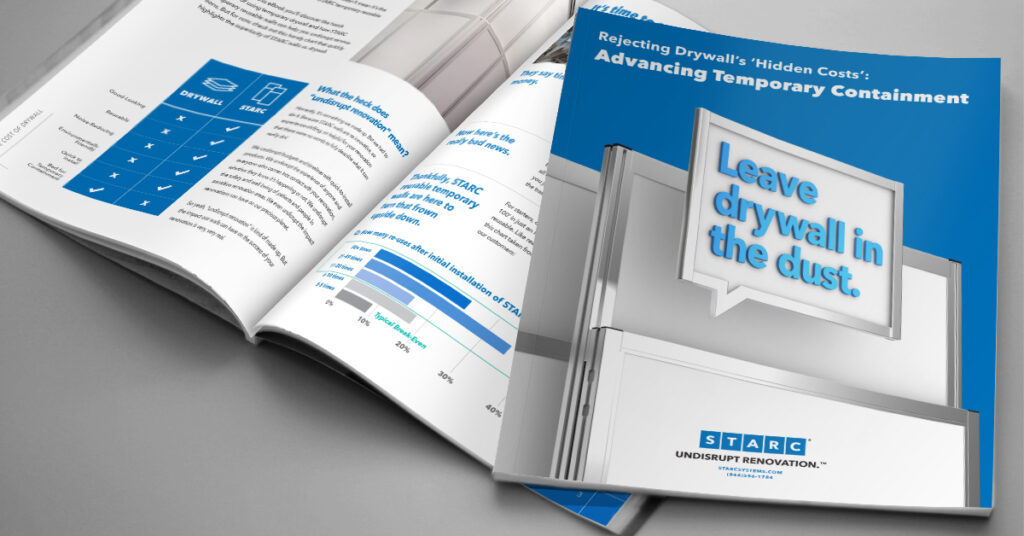
Updated September 16, 2025
Drywall has long been the default for temporary walls in commercial renovations. Project Managers often budget for it without question—using it to section off areas so businesses or facilities can remain operational during construction. But what those budgets often overlook is drywall’s hidden expense: labor, disposal, and waste.
Temporary construction walls from STARC provide a smarter alternative. By containing dust, debris, and noise while reducing costs and supporting sustainability, they help Facilities Managers and Project Managers achieve faster, cleaner, and more profitable renovations.
The Hidden Costs of Drywall
At first glance, drywall seems affordable. But in practice, it comes with recurring costs that add up quickly:
- Labor-Intensive Installation — Building and tearing down drywall takes time and skilled labor.
- After-Hours Work — Many healthcare and commercial projects require off-hours shifts to minimize disruption, driving up overtime pay.
- Disposal & Cleanup — Once removed, drywall becomes debris. Hauling and disposal fees create significant, unbudgeted expenses.
- Environmental Impact — Drywall is a single-use product. Most of it ends up in landfills, creating sustainability challenges.
Every phase of a renovation compounds these costs, turning drywall into an expensive “disposable” solution.
Disposable vs. Reusable: A Smarter Alternative
Drywall offers zero return on investment (ROI). Once a project ends, the material is scrapped. By contrast, STARC’s reusable modular wall systems—including RealWall™, LiteBarrier™, FireblockWall™, and StackBarrier™—are designed for use across hundreds of projects.
Unlike drywall, STARC walls:
- Install quickly with minimal labor.
- Contain dust, debris, and noise effectively.
- Provide a clean, professional appearance in occupied spaces.
- Can be reconfigured and reused, project after project.
- Align with sustainability goals by eliminating drywall waste.
ROI and Strategic Advantages of STARC Walls
When Project Managers factor in multiple phases and future renovations, the ROI becomes clear:
- Payback After 2–3 Uses — LiteBarrier achieves positive ROI after phase #2; RealWall after phase #3; FireblockWall with Cap after phase #2.
- Big Savings Across Projects — Five-phase savings range from $35,000 with RealWall to over $200,000 with FireblockWall.
- Lower Total Cost — At $5–10 per linear foot when amortized, reusable walls deliver long-term savings that drywall cannot.
- Faster Installations — Up to 100 linear feet per hour can be installed by a single worker, reducing labor costs.
- Sustainability Wins — By avoiding drywall disposal, Facilities Managers reduce environmental impact and align with green initiatives.

Want the full cost breakdown? Download our free eBook, Rejecting Drywall’s Hidden Costs, for a detailed ROI analysis and real-world examples.
FAQs: Drywall vs. Temporary Construction Walls
Drywall may seem affordable at first, but it requires skilled labor for installation and teardown, often adds overtime costs for after-hours work, and creates large amounts of debris that must be hauled away—making it a recurring, expensive choice.
👉 In short: Drywall is costly because of hidden labor, overtime, and disposal expenses.
Unlike drywall, temporary modular walls from STARC are reusable across hundreds of projects. They install faster, reduce labor costs, and eliminate drywall disposal fees, delivering long-term savings and faster ROI.
👉 In short: Temporary modular walls save money by being reusable, faster to install, and eliminating drywall waste.
Yes. STARC’s RealWall, LiteBarrier, FireblockWall, and StackBarrier systems exceed ICRA Class IV/V requirements, helping protect patients, staff, and visitors during occupied renovations.
👉 In short: Yes—STARC walls exceed ICRA Class IV/V requirements for infection control in occupied spaces.
Thanks to lift-and-drop connections, a single worker can install up to 100 linear feet of wall per hour—far faster than building with drywall.
👉 In short: A single worker can install up to 100 feet of wall per hour using STARC’s modular systems.
STARC walls typically achieve payback after just 2–3 uses. For example, LiteBarrier achieves positive ROI after phase #2, RealWall after phase #3, and FireblockWall with Cap after phase #2—delivering project savings of $35,000 to over $200,000 in five-phase jobs.
👉 In short: STARC walls typically pay for themselves after 2–3 uses and save $35K–$200K across multi-phase projects.
Takeaway: Smarter Renovations with Temporary Walls
Drywall may be familiar, but it’s costly, wasteful, and inefficient for temporary construction. STARC’s reusable modular wall systems provide a smarter path forward—one that saves money, supports sustainability, and delivers professional results in sensitive environments.
Talk to a temporary wall expert to learn how STARC’s wall systems can maximize ROI on your next renovation.
